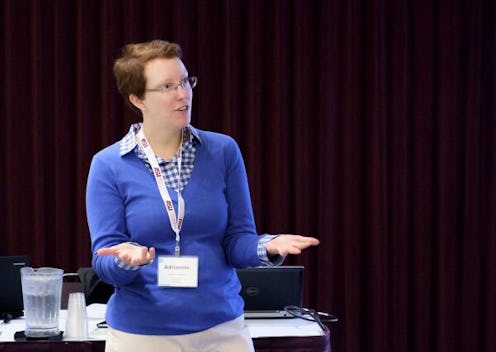News
Why You'll Miss This Late Wikipedia Editor

One of Wikipedia's most prolific editors, Adrianne Wadewitz, died earlier this month as a result of a rock-climbing fall. The 37-year-old was remarkable not just for her Wikipedia contributions, but for her focus on chronicling the overwhelmingly under-researched roles played by women in history and present-day life. Wikipedia — one of the most popular places on the Internet — is really going to miss her. And though they may not know it, so are its hundreds of millions of users.
The hallmark of Wikipedia is that it can be edited by anyone, but the core of the site runs on the input of a much smaller number of editors and contributors. These are the people who delete that dumb thing you added onto your high school's Wikipedia as part of a short-lived senior prank. They make additions to existing posts, start new articles on newsworthy topics, and try to ensure the site's content is balanced.
Here's the problem: Most of them are men.
Have you ever wondered why, when you ventured over to Wikipedia, you were able to read thousands of words about how exactly a particularly obscure Civil War battle played out, or examine the controversy underlying a functionally insignificant but widely disputed scientific detail in a Star Trek episode? Maybe not, because chronicling that kind of weird stuff is just what the Internet is good at, right? All fine and good, until you realize that topics more directly involving women — either their influence or their general interest — get much shorter shrift.
By way of example: An article on Elizabeth Cady Stanton, an influential figure in the women's rights movement, gets about 9,000 words in her Wikipedia entry. An article on Horatio Nelson, an officer in the British navy who fought in the Napoleonic Wars, gets 21,400.
The trend continues almost everywhere you look. A Wikipedia entry on jockstraps contains 1,000 words. An entry on spaghetti straps gets 66. Wikipedia's gender gap has been talked about for a few years — a New York Times article in 2011 pointed out that boys' childhood interests, like baseball cards, get far more coverage than girls' childhood interests, like friendship bracelets.
Here's where Wadewitz comes in. During the last ten years of her life, according to her obituary, she did her part to start balancing the gap as part of the roughly 15 percent of women regularly contributing to Wikipedia. During those ten years she authored 36 featured articles — those posts considered the best Wikipedia has to offer — and made (wait for it) more than 49,000 edits. 49,000.
Wadewitz's Twitter feed was full of examples of her efforts to get accurate information into the annals of history. And though it wasn't her only area of interest, she was perhaps most importantly a defender of and an advocate for the people less represented in Wikipedia's editorial ranks. Here are a few examples.
Wadewitz, who was originally from Omaha but lived in Los Angeles, also had a Ph.D. in British literature and was on the board of the Wikipedia Education Foundation. She really wanted more women to start editing on Wikipedia.
Image: @wadewitz/Twitter